STUCK IN THE MIDDLE: INSIDE CHINA’S ART CRAM SCHOOLS
| April 26, 2011 | Post In LEAP 8
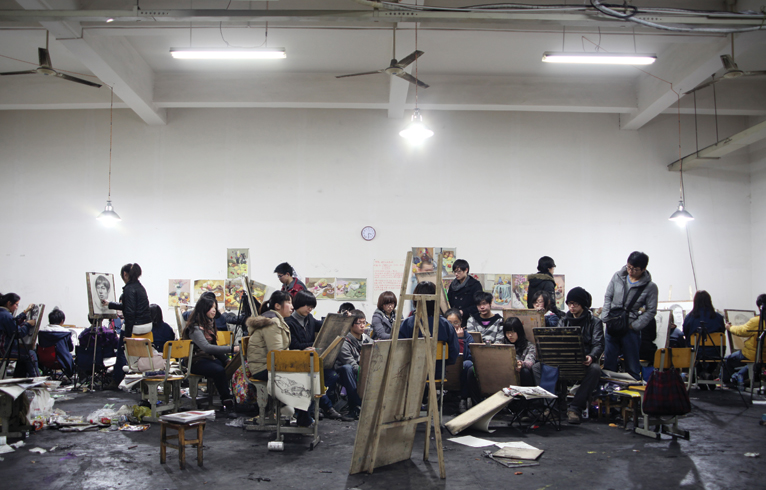
For China’s art cram schools, things heat up just before the Lunar New Year and keep going until the fireworks have stopped. Many a hopeful art academy entrant, scared by the duo of provincial exams and school-specific art exams just around the corner, spends China’s highest holidays in the classroom. This is the tensest period for students and teachers alike, a time when months of training come to fruition, or don’t. Sure, the successful examinee will be back at it again in June, taking the famed general examination, the gaokao, with the rest of the nation’s aspiring collegians, and plenty will fail to pass muster. By then, the cram schools will be at rest, their teachers idly preparing to welcome a new batch of students along with a few unlikely repeats come fall. It’s a cycle, and a system, that has come to seem natural, when in fact, it’s unparalleled anywhere else in the world, the bastard progeny of an examination regime and an education system both in need of reform. Wedged into this strange crevice of Chinese education, the schools thrive, offering the convenience and practical results the system calls for. The cram schools don’t think about preparing the students for the four years that follow, let alone anything beyond that. They just teach them how to get in.
IN THE CLASSROOM
By the end of February there are only a few students left in this cram school classroom, practicing sketching; the majority have returned to their high schools to prepare for the cultural exams. There is no longer the compressed determination of earlier in the term, no longer the vitality of adolescent heads huddled together. A few students are posing as models; in the last few years the exams have started to use younger models, but the cram schools can only hire elderly retirees, so the students are forced to practice by drawing each other. A chill runs through the classroom, and although the days will soon become warmer, most students are dressed for the outdoors, in thick winter coats. The floor is dirty, littered with paints and trash. Sample works by the instructors cover the wall, along with an uneven horizontal row of student sketches. Next to these are recent exam schedules, and an analogue countdown calendar that has not been updated. A cluttered corner harbors the plaster busts and plates of fruit from earlier units in the course. The few seconds of attention diverted to this outside visitor have already passed; almost instantly the students are back to their drawing boards. It is past nine o’clock in the evening.
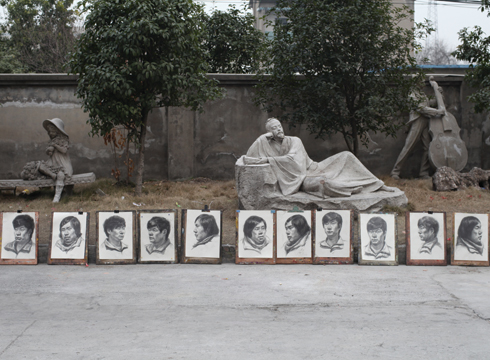
Courses at this cram school, in Hangzhou’s Binjiang District, run from eight in the morning to eleven at night, with the studios available for use twenty-four hours a day. Near the classroom’s entrance is a simple punch clock: students are fined RMB 10 for tardiness and RMB 50 for each absence. Nevertheless, there are those who would rather play, and who can afford to spend this “cut money.” Dormitories are located in a nearby building just a few minutes walk away, connected by a wellbeaten path.
The corridors are deep, exuding the must of an old office building. This building is primarily occupied by cram schools in every discipline, with art studios taking up one floor. Occasionally a few students scurry by, toting plastic bags full of food. They also carry with them an air of anxiety, and oppression. Some of the students still in the studio tonight will be rushing to Wuxi the tomorrow to take the Tsinghua University Academy of Arts and Design admissions examination. A group of teachers will go with them; upon their arrival that night, class will continue in the hotel room. The exam will comprise three subjects: three hours of watercolor in the morning, four hours of drawing in the afternoon, then one hour of sketching.
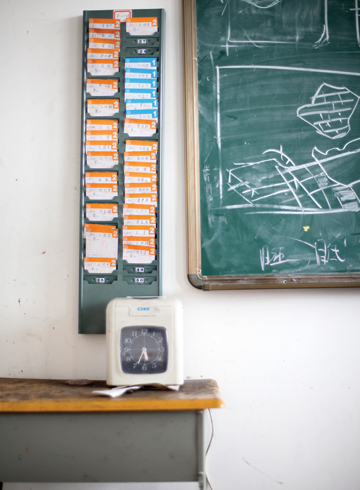
That teachers accompany students to examinations was not a conventional practice in the past. Yet, as the cram-school industry itself has grown more competitive, this has become a basic service. It is said that in Hangzhou alone there are 200 cram schools, big and small, and that the “big schools,” i.e. those with more than 300 students, number more than twenty. It is also said that a well-managed school can make upwards of RMB 1 million in annual profits. In other words, the schools have already become highly “industrialized.” Due to the presence of the China Academy of Art (CAA), Hangzhou has become the primary test-prep destination for students from throughout the region, and even from provinces as far off as Jiangxi and Yunnan.
Zhou, an instructor graduated from CAA, began holding cram classes there during his freshman year. He has been doing this for six or seven years. According to him, back then all you had to do was rent out someone’s house and bring a few dozen students; that was already considered a cram school of some scale, and the students didn’t have many demands of their teachers. Nowadays, boutique cram schools like his have grown rare. Rents have gone up, costs continue to increase, and parents and students alike place greater emphasis on classroom facilities, level of teaching experience, and student acceptance rates. The larger schools, naturally, are more competitive on these counts; some even offer special classes that promise a partial tuition refund to students who do not pass. (Of course, tuition for these special classes is even higher.) The average cost for a six-month course in Hangzhou is around RMB 10,000. The Chinese nomenclature, which refers to these organizations as “pre-test classes,” barely applies anymore; the classes have become full-fledged “schools,” as tightly managed as normal secondary schools.
TEACHING TO THE TEST
The Chinese college entrance examination system has faced criticism for a long time, and combined with the university enrollment expansion policies of recent years, has led to skepticism about the overall quality of the higher education system. In the 1990s, the national policy of “expanded enrollment” made its way from the research universities to the art academies, transforming prestigious but formerly tiny schools into major institutions. Combined with the concurrent rise of contemporary Chinese art, the transformation of the academies— which had produced nearly all of the newly successful artists— could not happen independent of larger trends in the art world. But regardless of what reforms have been implemented and what new departments have popped up, one thing remains unchanged: anyone who wants to study art must first pass this entrance examination. Even the specific content of the exam remains basically unchanged since the 1950s, focusing on the trivium of sketching, drawing, and color.
Sketching, drawing, color— that is all the cram schools teach. As soon as assignments are finished, they are placed outside the classroom, next to a flowerbed, and lined up in a row. The teacher, accompanied by students, then proceeds to critique each work, one by one, reinforcing existing standards. According to one instructor, “The issue is a fairly practical one: people pay money to come here so that they can get into the academy, and you have to respect that money. It’s very simple. Don’t get carried away with anything else. If you go away babbling half the time and the students don’t get accepted, then you’ll just have been blowing hot air.” He goes on to recount how many times he’s had friends who— with a child in his or her junior year of secondary school and less than remarkable grades— have asked how plausible it would be for their child to start learning to draw. Would it be too late to learn? Would it still be possible to get into CAA?
Another instructor explained, “A few years ago, back when nobody was so eager to get rich quick, students were taught in earnest, they would have to draw everything. You could say that the long-term took priority. There was no special emphasis on taking examinations. In the end we discovered that teaching ten students in this way, perhaps only two would go on to test well. Three would test just average, and five would do poorly. Later it became about making quick gains, as the basic foundation students possessed just got worse and worse. Some had never studied art before in their lives. All we could do was teach them shortcuts, whatever it took just to elevate their overall scores.”
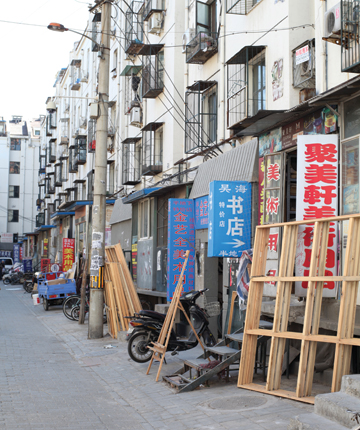
Shifting standards exacerbate the problem. Each year, the works given the highest marks at top schools steer the direction in which cram schools head for the following year. Last year, Tsinghua released high-scoring exam papers for the first time since the school made reforms, and CAA publishes a volume of high-score exams every year. For cram schools, this is a huge convenience, as they can proceed to directly reflect on the trends and tastes of the evaluation process towards planning the subsequent year of teaching. This also has acted as a catalyst for several interesting “inventions.” In the materials room of one school there is a socalled “CAA Gray Series” of colors, said to be made at the peculiar whim of a CAA graduate according to the preferred pigmentations as mixed at CAA. Before, it was popular practice to have examinees mix their own watercolors, but now, even this step can be skipped. The phrase “a good sense of color” is no longer applicable, as all a student has to do is use the existing colors correctly.
Adjusting to detailed changes in examinations is perhaps the only arena in which cram schools must “innovate.” Sometimes, students will be caught off-guard with “surprise” topics in exams. As one cram school instructor said, the topic for Zhejiang University’s art department admissions exam one particular year was “bees collecting nectar.” This so-called “strange topic” is one that would certainly never appear in class, but it is also a so-called “innovative topic,” for it aims to test students’ imagination and creativity. There’s also the case of color examinations, which formerly required students to sketch from models or objects in the room. Now, students sketch from memory. Whereas before, emphasis was placed on shape, it is now placed on color. “We later discovered that, especially in CAA’s case, a lot of attention is paid to color, so we took, for example, the colors from a certain part of an Impressionist painting, some white, some yellow… they would form the most basic black, white and gray relationship. The color combinations we arrived at were nice, and they would shine in people’s eyes. During those couple years when we first made the change, it was fairly easy to get a high score.” These days, painting teachers will choose a few dozen colors, and after the relations among colors is explained, students have little left to think about. All they have to do is master these relations, and voila.
“Our teaching also influences the exam graders’ taste!” jokes one painting instructor. Yet within this mutual influence, both sides seem to have reached a consensus of sorts. This consensus is not necessarily some “secret pact” between cram schools and academies. Rather, it is a method for the basic, peaceful coexistence of the two formed by the link between preparatory and secondary schools, a self-propagating ecological system that allows for smooth, unhindered turnover.
FUTURE ARTISTS, ANYONE?
During a break from class, a few young girls jokingly say they aren’t interested in getting into art; they want to do design. However, they didn’t even seem to grasp what exactly they would be studying after entering their specialization. This information isn’t something that preparatory courses offer students. Here, art is not discussed, only exams.
To what degree is this exam today actually related to becoming an artist tomorrow? We note that most cram-school students didn’t actually have a grasp of the concept of the “artist.” In this way, the exam is different from the similarly strict exams for Beijing Film Academy, Central Academy of Drama or China University of Communications. The appeal of becoming a “successful artist,” after all, is a distant (and less clear) cry from that of a movie star or even a news anchor. In a way, things are better in the performing arts— at least the teenagers taking those examinations have an inkling of what it might mean to be an actress. But for most aspiring students of the fine arts, there isn’t too big a difference between drawing a straight line in the studio and drawing the right line in analytical geometry class. For many, the decision to attend art school is neither rooted in some deep passion for art, nor even a fundamental interest in art. It’s simply a last resort for students whose grades in cultural courses weren’t exactly ideal.
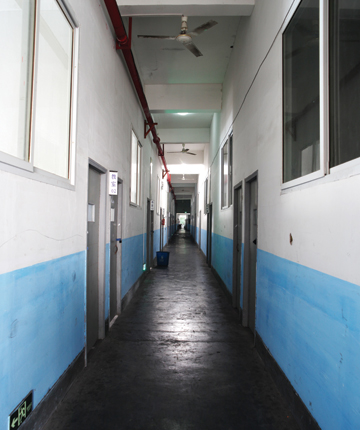
As far as new specializations like “new media” go, the discrepancy between admission standards and course content is even more pronounced. In speaking about his own experience as a student, artist and CAA professor Zhang Peili [See page 122] mentions that some people think “new media” is about studying software. As incredible as it sounds, this ignorance is a great source of helplessness for instructors, as well as pain for students. Zhang recounts a student of his who, while creating his senioryear graduation piece, finally spoke candidly: if he heard the word “installation” one more time, he would vomit. “Forty-five out of fifty students will, later on, have nothing to do with any of this,” says a resigned Zhang.
He goes on to say, “Of course, the administration likes to say that the West is also like that, that most students waver from their specialization after graduation, but I believe the situation here is different. For one, due to the ratio of applicants to admitted students. There’s also the fact that in the West, art students already have a very clear understanding of what they are getting into even before they begin their studies. They know that art school is hard, that one must consider whether or not one’s personality and abilities are suitable for art.”
CAFA, CAA, and Tsinghua are different from other art academies and programs in that the students they admit are the very best. Even so, this doesn’t solve a basic problem. “CAFA still divides specializations traditionally, according to medium. Essentially, this kind of skill-based training and evaluation is only useful to ‘model’ schools, and anyway, many students admitted these days are majoring in new media or design,” says gallerist and CAFA professor Pi Li. But one will find that after gaining entrance to art academies, there are few differences with regular universities. Pi mentions the difference between “elitist education” and “education for the masses.” Under the current system of examination and enrollment increases, there is slim chance of CAFA proffering any sort of “elitist education.” These days, undergraduate classes can reach up to 100 students, enough, in fact, that the professor has no chance to teach by personal example, to be hands-on with students. Only graduate students get the luxury of having an advisor. Before, students were able to “be worth their salt” after finishing their undergraduate studies, but today education overall seems to have been “postponed.” Faced with his own students, Pi says he can only “wear them down slowly.” Under the current rigid conditions, then, can art academies educate students to become artists? Using what methods? This is the question that academy instructors with a mind to make a difference must face.
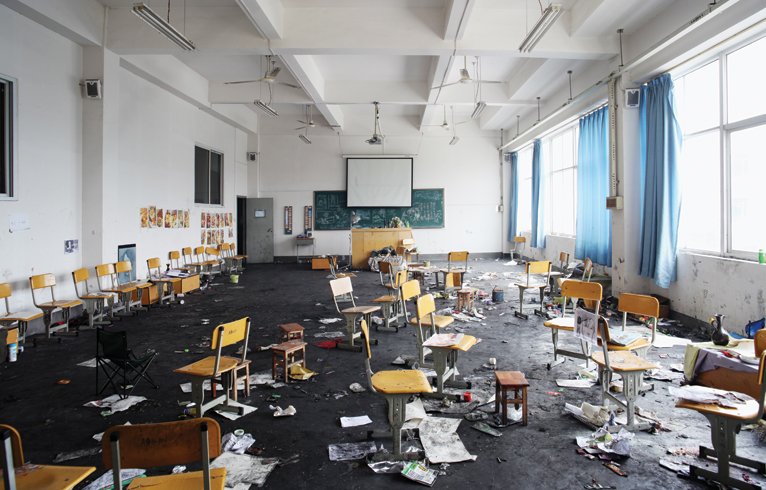
The cram schools we visited in Hangzhou were by no means anywhere near the China Academy of Art’s main campus. Most were located around Binjiang or Zhuantang, far from the high-rent areas of the city. However, even in this outlying area, yearly rent for a cram school can run upwards of a few hundred thousand RMB. It’s a considerable business. As February examinees gradually begin to leave, the schools are faced with next year’s legwork, with the need to promote and to recruit new students. The instructors, some of whom are CAA graduates, sometimes talk about their previous studies. It seems as if all of them wished they had the opportunity to continue creating. But rarely do people manage to escape from here. Even less do they feel the spark of inspiration or inject creativity into the job. The “freak child” that is the Chinese art cram school is born of two parents: test-takers and their teachers. Seen up close, it’s difficult to blame things on either side. Both are party to this vicious cycle, meekly accepting responsibility for the peculiar regime, which they submit to, and thus propagate.


